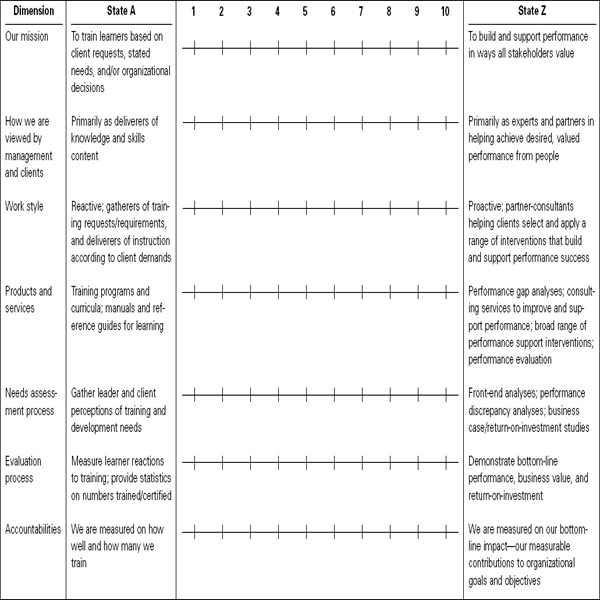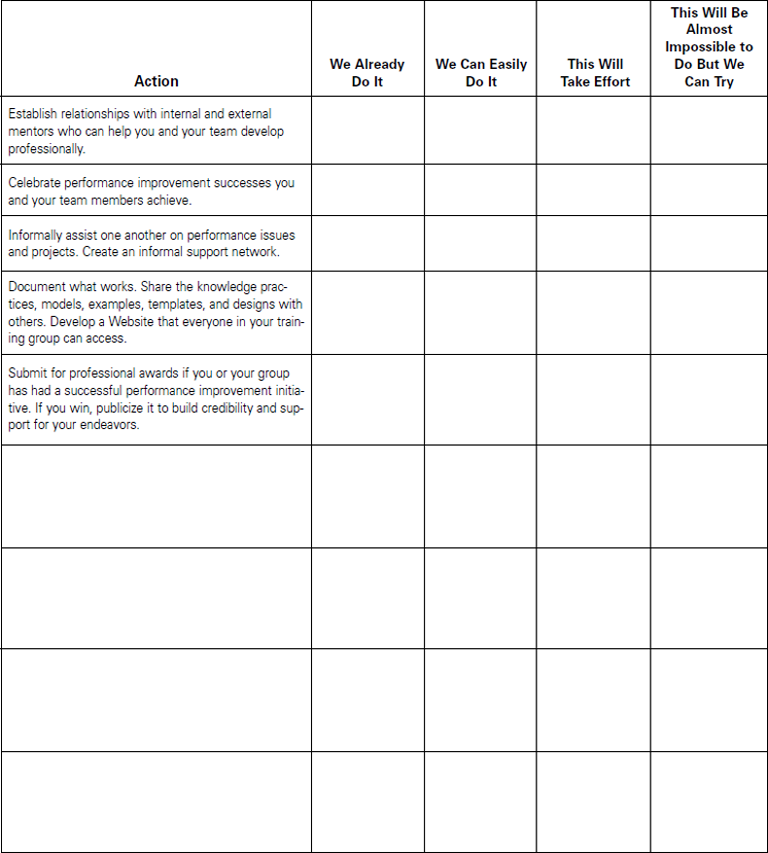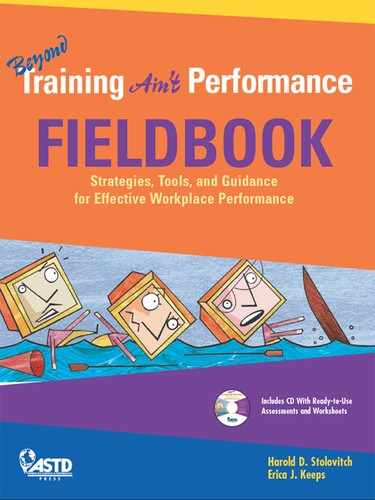Chapter 14
Beyond Training Ain't Performance: Ongoing Growth and Development
This chapter
![]() returns to the start of Beyond Training Ain't Performance and has you and your WLP team assess, for a second time, where you currently are and where you want to be on seven Training Ain't Performance dimensions
returns to the start of Beyond Training Ain't Performance and has you and your WLP team assess, for a second time, where you currently are and where you want to be on seven Training Ain't Performance dimensions
![]() recommends, with guidelines, setting up a support system for your environment
recommends, with guidelines, setting up a support system for your environment
![]() helps you diagnose facilitating and inhibiting factors in moving from training to performance
helps you diagnose facilitating and inhibiting factors in moving from training to performance
![]() helps you exploit facilitating factors and eliminate inhibiting ones
helps you exploit facilitating factors and eliminate inhibiting ones
![]() recommends, with suggestions, forming a Training Ain't Performance study group
recommends, with suggestions, forming a Training Ain't Performance study group
![]() provides a performance instrument and guidelines for use in planning your professional development and growth.
provides a performance instrument and guidelines for use in planning your professional development and growth.
Tools in this chapter include
![]() a Training Ain't Performance individual evaluation, identical to the one you used in chapter 2
a Training Ain't Performance individual evaluation, identical to the one you used in chapter 2
![]() a Training Ain't Performance evaluation of your organization, also identical to the one in chapter 2
a Training Ain't Performance evaluation of your organization, also identical to the one in chapter 2
![]() an Actions to Take in Building a Support System worksheet to help you create ways to support your progress toward becoming the performance support organization you would like to be
an Actions to Take in Building a Support System worksheet to help you create ways to support your progress toward becoming the performance support organization you would like to be
![]() a Support System Action Plan to make sure you develop an effective support system
a Support System Action Plan to make sure you develop an effective support system
![]() a Personal Facilitating and Inhibiting Factors template to help you sort through what will help you grow and develop and what potentially can hold you back
a Personal Facilitating and Inhibiting Factors template to help you sort through what will help you grow and develop and what potentially can hold you back
![]() a Personal Actions to Exploit Facilitating Factors and Decrease Inhibiting Factors worksheet
a Personal Actions to Exploit Facilitating Factors and Decrease Inhibiting Factors worksheet
![]() an Organizational Facilitating and Inhibiting Factors worksheet to help your team isolate system elements that can either help or hinder team advancement
an Organizational Facilitating and Inhibiting Factors worksheet to help your team isolate system elements that can either help or hinder team advancement
![]() an Organizational Actions to Exploit Facilitating Factors and Decrease Inhibiting Factors worksheet
an Organizational Actions to Exploit Facilitating Factors and Decrease Inhibiting Factors worksheet
![]() a performance instrument and guidelines to help plan your professional development and growth.
a performance instrument and guidelines to help plan your professional development and growth.
In chapter 2 of this Fieldbook, you and your WLP group had an opportunity to conduct a Training Ain't Performance self-assessment. The instrument you used had seven dimensions to it. You indicated where you currently are on each of these dimensions and where you want to be. Without looking back at your earlier answers, assess yourself again now that you have begun applying the principles, guidelines, and tools of both Training Ain't Performance and the Beyond Training Ain't Performance Fieldbook. We've reproduced the instructions and instruments for you in this chapter. Remember, do it on your own first (Assessment 14-1). Then, preferably, you and your team do the second one (Assessment 14-2). When you've completed these, go back and look at your completed assessments from chapter 2. Take note of any differences.
To complete Assessment 14-1, take the following steps:
- For each dimension, read the descriptions at both ends of the continuum.
- For each dimension, using pens or pencils of different colors, place an “X” on the continuum at those points you consider to be your own current state (one color) and your own desired state (second color). Be consistent. Always use the same color for current and the same second color for desired.
- When you have placed all of your Xs in both colors, use a ruler to join all Xs in the current color and then join all Xs in the desired color. You'll have two (probably zig-zag) vertical lines. Here is an example (current = solid line; desired = dashed line).

Assessment 14-1: Training Ain't Performance Individual Evaluation

Assessment 14-2: Training Ain't Performance Organizational Evaluation

- Note the discrepancies between the two zig-zag lines. A distance of three or more points between desired and current states on any dimension suggests that you have a lot to do to move from where you are to where you want to be.
The instructions for completing Assessment 14-2 are very similar to those for the Individual assessment. However, it is best done by a group of interested parties. Pull together fellow team members, your manager, and, if possible, a client or two whom you regularly serve. Allow for ample discussion while making up your minds on where to place the Xs.
- For each dimension, read the descriptions at both ends of the continuum.
- For each dimension, use pens or pencils of different colors to place an “X” on the continuum at the point the members of your group believe should be your training, learning, or WLP organization's desired state (one color) and at the point they consider to be your training, learning, or WLP organization's current state (second color). Ensure consistency in the use of the two colors.
- When all Xs have been placed in both colors, use a ruler to join the Xs in the current color and then join all the Xs in the desired color. Once more, you should end up with two irregular vertical lines. Here's an example (current = solid line; desired = dashed line).

- Note the gaps between the two zig-zag lines. A distance of three or more points between desired and current states suggests that your organization has a lot to do to move from where it is to where it would like to be.
Were there any significant current or desired changes for you or your organization compared with your selections in chapter 2? We don't anticipate large changes for you, personally, with respect to desired performance, but we do hope that current is beginning to edge closer to desired for you, and that your organization has progressed in its desired thinking. With time, you should experience greater convergence between current and desired states on all seven dimensions. Please self-assess again in four to six months and then two to three times annually. Doing so will keep you thinking about what more there is that all of you can do to become a WLP organization as you would wish it to be.
Building a Support System for Your Environment
Trying by yourself to become an effective performance improvement professional simply may lead to frustration. You need support to be successful within your organization. So do your colleagues. Here are some suggestions for building your and your group's support system. It's a starter list that should trigger ideas of your own.

An Activity for You
Read through the list in Worksheet 14-1. Check off those items that have appeal and are feasible in your environment. Cross through those that do not apply. Add your own actions to this list. Place your checkmark in the appropriate columns.

An Activity for Your WLP Team
Share with your group the list of retained actions (including your additions) in Worksheet 14-1. Ask if they would keep all the actions you retained and if they would place the checkmarks as you did. For each action your group retains, figure out what is needed to make it happen. Prioritize the actions on the list. Then develop a time and action plan for each. Assign responsibilities. Worksheet 14-2 can help with this.
Facilitating and Inhibiting Factors in Moving from Training to Performance
Progressing toward the desired state from where you currently are as indicated in your Training Ain't Performance assessment is an evolutionary process. It always takes longer than you think it should.
To reduce the time—and the obstacles—you must carefully analyze your current environment and practices. You also have to assess objectively your current competency levels, resources, expectations, and myriad other factors that can influence your practice. One way to start is to make a list of existing factors that you feel can facilitate the transformation from training to performance. Then do the same list-making for inhibiting factors.

An Activity for You
Start with yourself. Be totally honest. List physical, emotional, spiritual, intellectual, social, professional, personal, and other factors or issues that either facilitate or inhibit your personal transformation. Forewarned is forearmed. Use Worksheet 14-3. Make each list as exhaustive as possible.
If you've been rigorously honest with yourself, both lists should be fairly long. Unfortunately, the inhibiting factors column often ends up somewhat longer. Nevertheless, this is your reality. Your next step is to decide how you can go about exploiting the facilitating factors and eliminating or at least decreasing the inhibiting ones. Worksheet 14-4 can help you do this.
Worksheet 14-1: Actions to Take in Building a Support System
Instructions: Read the list of actions in column 1 and cross out any that have no appeal or are not feasible in your work setting. For all remaining actions, place a checkmark in the appropriate column beside each action listed below. Add descriptions of other actions that are interesting or feasible in your work setting and place checkmarks for them.


Worksheet 14-2: Support System Action Plan

Worksheet 14-3: Personal Facilitating and Inhibiting Factors
Instructions: List your physical, emotional, spiritual, intellectual, social, professional, and personal factors that can facilitate or hinder your transformation as a performance improvement professional.

Worksheet 14-4: Personal Actions to Exploit Facilitating Factors and Decrease Inhibiting Factors
Instructions: Describe the actions you can take to make the most of those personal factors that facilitate your transformation and those actions you can take to decrease or eliminate the factors that hinder your transformation.

The following exhibit presents several examples to trigger your own ideas:
| Facilitating Factors | Actions to Exploit |
|
|
| Inhibiting Factors | Actions to Eliminate/Decrease |
|
|

An Activity for Your WLP Team
As you did for yourself, now extend your thinking to your organization. Using Worksheets 14-5 and 14-6 as a group, list facilitating and inhibiting factors first. Then list actions to exploit facilitating factors and eliminate or decrease inhibiting ones. If you feel it is appropriate, share your personal lists from the work you did above.
The lists and actions you and your group have generated are extremely valuable as you move forward from current to desired states. Keep these close at hand and refer to them frequently to maintain the progress. As you exploit the facilitating factors and work to reduce or eliminate the inhibiting elements, changes will occur more rapidly.
Form a Training Ain't Performance Study Group
Training Ain't Performance and the Beyond Training Ain't Performance Fieldbook are resources to be used. One way of using them is to create a study group. Ask each person to accept responsibility for leading the discussion about one chapter or topic. Set a calendar of meetings (live or virtual) when the group can gather to discuss what they read, tried, and discovered as they went through the assigned material.
The discussions should include
![]() what are the key concepts, principles, or practices?
what are the key concepts, principles, or practices?
![]() how do these add value to learning? to performance? to our organization?
how do these add value to learning? to performance? to our organization?
![]() what conclusions should we draw based on our readings or experiences?
what conclusions should we draw based on our readings or experiences?
![]() what action plans can we create?
what action plans can we create?
![]() how do we verify results of our actions?
how do we verify results of our actions?
![]() how do we obtain required approvals and support?
how do we obtain required approvals and support?
Worksheet 14-5: Organizational Facilitating and Inhibiting Factors
Instructions: List the group's physical, emotional, spiritual, intellectual, social, professional, and personal factors that can facilitate or hinder its transformation as a performance improvement team.

Worksheet 14-6: Organizational Actions to Exploit Facilitating Factors and Decrease Inhibiting Factors
Instructions: Describe the actions the group can take to make the most of those factors that facilitate its transformation and those actions it can take to decrease or eliminate the factors that hinder its transformation.

These are suggested questions only…starting points for your ongoing growth and development.
Plan Your Professional Development and Growth
Before we conclude this important chapter, we want to provide you with a means and tool for creating and monitoring your own professional development plan (PDP). Any time is the right time to put this development plan in place. It begins where you are now and lays out steps to take you where you want to go. In Worksheet 14-7 you'll find a format for creating your PDP.
Here are the steps to follow:
- Identify and list performance areas requiring development:
• technical
• work practices
• interpersonal.
- Identify and list areas of strength to enhance.
- List career aspirations—future positions or opportunities.
Worksheet 14-7: Creating Your Professional Development Plan
Instructions: Fill in column 1 and then complete the other columns for each entry you have made in column 1.

- List subjects of special interest to be pursued.
- Beside each listed item, prescribe internal activities, experiences, and assignments; external activities, courses, events; self-regulated activities that are appropriate to achieve a successful outcome.
- List start dates and checkpoint dates.
- Describe your success criteria.
When you've created your PDP, it's up to you to work that plan. Set realistic but challenging goals for yourself. Monitor your performance against the plan, gently bring yourself back on track if you stray. Modify the plan as you see fit. Reward yourself for your progress and accomplishments.
Chapter Summary
What a heavy-duty chapter! Let's review what happened.
![]() You assessed yourself and your organization again, just as you did in chapter 2 of this Fieldbook. You then were able to compare perceptions of current and desired states for you and your WLP group then and now.
You assessed yourself and your organization again, just as you did in chapter 2 of this Fieldbook. You then were able to compare perceptions of current and desired states for you and your WLP group then and now.
![]() You reflected on how to build a support system for yourself and for your group. You generated actions to take in both cases and created action plans for making these happen.
You reflected on how to build a support system for yourself and for your group. You generated actions to take in both cases and created action plans for making these happen.
![]() You identified facilitating and inhibiting factors in your environment with respect to moving to your desired states. Once more you created action plans to exploit facilitating factors and eliminate or decrease inhibitors.
You identified facilitating and inhibiting factors in your environment with respect to moving to your desired states. Once more you created action plans to exploit facilitating factors and eliminate or decrease inhibitors.
![]() You concluded the chapter by considering suggestions for setting up a Training Ain't Performance study group.
You concluded the chapter by considering suggestions for setting up a Training Ain't Performance study group.
In this chapter we gave you a number of ideas and support materials. These should help you as you leave us. But before we say “goodbye and good luck,” we give you one last action item. Review this chapter a second time very soon. Select from it what you can feasibly do for ongoing growth and development for yourself and your colleagues. Get started now. Don't let inertia work against you. Organize with your teammates. Get your management onboard. Use the tools and suggestions in this chapter, and move yourself and your WLP support team to a new level by making significantly more contributions to your organization.
In the next chapter we turn to external support systems that can help you and your organization make the transition.
